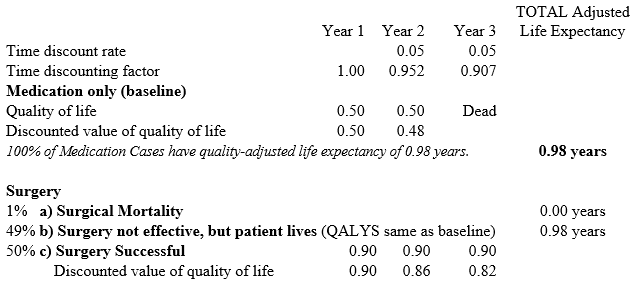Consider a hypothetical example in which a patient has a condition in which she can expect to live only 2 more years on medications, with her quality of life reduced to 50% during those 2 years. With successful surgery as an alternative, she can expect instead to live 3 years with a better quality of life, 90%. Surgical mortality rate is 1% and the surgery is successful half the time. Using a 5% time discount rate, a student in health economics class correctly sets up the analysis.

-If the patient decides to have the surgery (compared to the baseline option of taking medications instead) , the quality adjusted life expectancy (number of QALYs) after accounting for both probability of success and surgical mortality is
A) 2.58.
B) 1.77.
C) 0.98.
D) 0.79.
E) 0.48.
Correct Answer:
Verified
Q11: A problem with Cost-Benefit Analysis is that
A)
Q12: A kidney cancer drug delays cancer progression
Q13: One of the weak points in the
Q14: The primary costs to be accounted for
Q15: It has been observed that some people
Q17: Consider a hypothetical example in which a
Q18: Consider a hypothetical example in which a
Q19: Consider a hypothetical example in which a
Q20: A U.S. emergency relief agency is
Q21: A U.S. emergency relief agency is
Unlock this Answer For Free Now!
View this answer and more for free by performing one of the following actions

Scan the QR code to install the App and get 2 free unlocks

Unlock quizzes for free by uploading documents